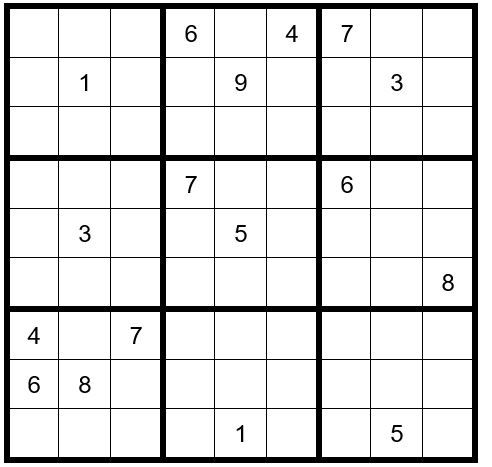
PUZZLE PREPARATION
Prior to utilizing techniques first complete the 5 Steps of Puzzle Preparation …
- FILL IN DATA FROM OBSERVATIONS
- FILL IN OBVIOUS ANSWERS
- FILL IN NOT-SO-OBVIOUS ANSWERS
- MARK UNSOLVED CELLS WITH OPTIONS THAT CANNOT EXIST IN THOSE CELLS
- FILL IN THE OPTIONS FOR THE UNSOLVED CELLS
DAN’S 8-STEP APPROACH TO SOLVING ALL SUDOKU PUZZLES
Once you have completed the puzzle, to the extent that you have filled-in all obvious answers and have written all potential options across the top of the unsolved cells (PUZZLE PREPARATION), Dan recommends the following Steps to complete the puzzle.
Step 1: Sudoku Pairs, Triplets and Quads – See September 2015
Step 2: Turbos & Interaction – See October 2015
Step 3: Sudoku Gordonian Rectangles and Polygons – See November 2015
Step 4: XY-Wings & XYZ Wings – See December 2015
Step 5: X-Wings – See January 2016
Step 6: DAN’S YES/NO CHALLENGE
Step 7: DAN’S CLOSE RELATIONSHIP CHALLENGE
Step 8: AN EXPANSION OF STEP 7
Steps 1-5 are relatively common techniques and are explained in the TI LIFE articles above. Steps 6-8 are covered in detail, in Dan’s book.
If we say 7 saves 6, those of you who have been following my articles will probably realize the meaning!
Puzzle #58
This month we will again complete all of the first 4 steps in the order we observe them, versus all step 1, then step 2, step 3, and step 4 in order, before we move on to step 5.
We will start with the 1’s and navigate through 2’s to 9’s, then repeat the process until we conclude all step 1-4 clues. The first thing we observe is that C3R8 (cell in column 3, row 8) =1 (obvious answer). Then C2R7=5.
We then realize that C1R9, C2R9 & C3R9 are an obvious triplet 239. Mark those cells with op-tions 239 (C2R9 with 29 because there is already a 3 in column 2. That leaves C4R9. C6R9, C7R9 and C9R9 with options 4678. There is already a 6 and 7 in columns 4 and 7; therefore, C4R9 and C7R9 have options 48, and C6R9 and C9R9 have options 67.
In box 6, C7R6 & C9R4 must have options 35, so mark them as such.
C2R1, C2R3, & C2R6 can only have options 24679. There is already a 4, 6, and 7 in row 1; therefore, options for C2R1 are 29. Notice that we already know C2R9 has options 29, an obvious pair. So now C2R3, C2R4 & C2R6 can only have options 467. We already have a 6 and 7 in row 4, so C2R4=4, and options for C2R3 and C2R6 must have options 67.
The only cells in box 2 that can be a 1 are C4R3 and C6R3; therefore, a 1 cannot exist as an option in C7R3, C8R3 and C8R3. Place a small 1 in the bottom of those three cells to indicate they cannot be a 1. Now your grid should look like Example #58.1 below.
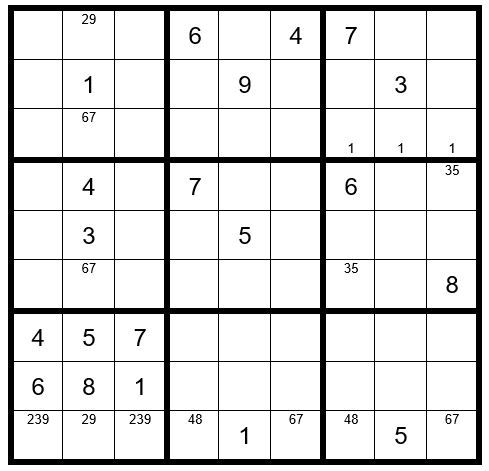
We have now completed Puzzle Preparation steps 1-4, so we will fill-in the options for the un-solved cells. Now your grid should look like Example #58.2 below.
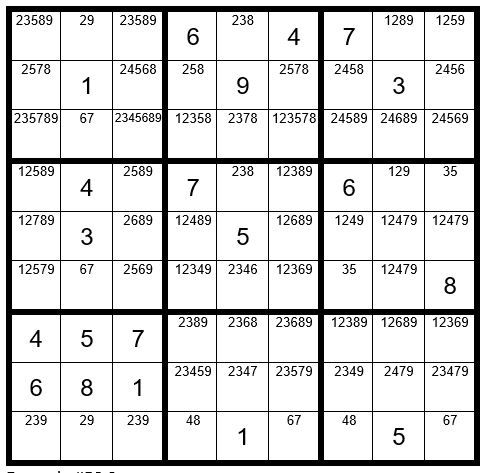
There are no Step 1 – 5 clues, so we will now proceed to Step 6: Dan’s Yes-No Challenge.
There are 3 circumstances that establish the potential for a Step 6 exercise:
- Look for just 2 unsolved cells in a box that contain the same option where these 2 cells are not in the same row or column.
- Look for just 2 unsolved cells in a column that contain the same option where these 2 cells are not in the same box.
- Look for just 2 unsolved cells in a row that contain the same option where these 2 cells are not in the same box.
We will start by searching the 1’s to see if there is a potential Step 6 clue, and then navigate through the 2-9’s.
In column 2 we find two unsolved cells with option 6. We will call these two cells our “driver cells” which drive the exercise. One of these two cells must be a 6. We will first start with C2R3 and assume it is the 3, to see what effect it has on the other unsolved cells with option 6. Then, we will assume C2R6 is the 3, to see what effect it has on the other unsolved cells. We will annotate C2R3 with a “Y” for yes, and annotate C2R6 with “y” to indicate yes. Please refer to Example #58.3 below:
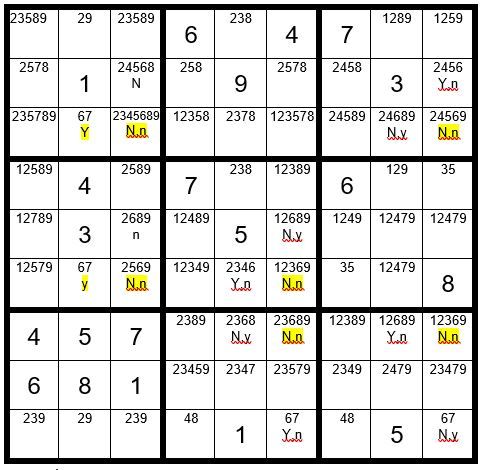
If C2R3=6 (Y), then, C3R2, C3R3, C8R3 and C9R3 are not a 6 (N). Then, the only cell in box 3 that can be a 6 is C9R2. Then it follows that C9R7 and C9R9=N, C8R7=Y, C5R7 and C6R7=N, C6R9=Y, C6R5 and CC6R6=N, C5R6=Y, and finally, C3R6=N.
If C2R6=y, then C3R5, C3R6, C5R6 and C6R6=n, C6R5=y, C6R7 and C6R9=n, C5R7=y, C8R7 and C9R7=n, C9R9=y, C9R3 and C9R2=n, C8R3=y, and finally, C3R3=n.
As you see, there are six unsolved cells that have a N,n designation. What is the significance? We have already stated that one of the two driver cells in column 2 must be a 6. The cells with the N,n designation cannot be a six regardless of which driver cell is a 6. The 6 can be eliminated from all N,n cells, giving us Example #58.4 below:
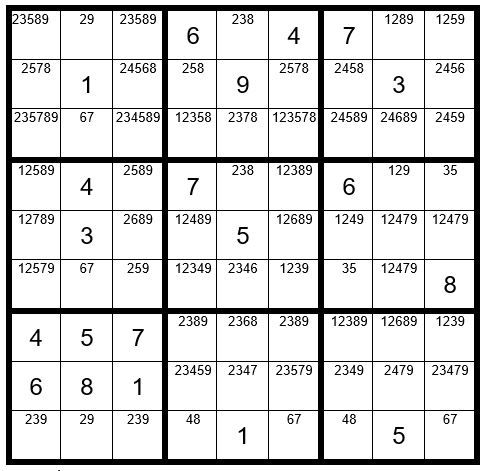
There are no other successful Step 6 exercises so we will move on to Step 7: Dan’s Close Relationship Challenge. Please refer to Example #58.5 below:
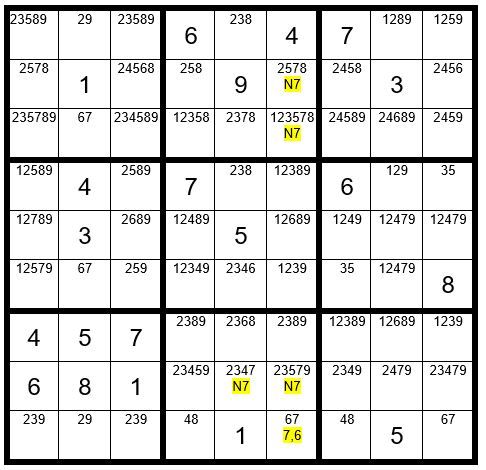
In this exercise we will select any two-option unsolved cell as the driver cell. My first choice is C6R9, with the sequence 7,6 as marked above. I chose this cell and sequence because this cell has 4 adjacent unsolved cells with 7 as an option and the 6 may track through the puzzle to give us significant information.
Follow the logic above in Example #58.5.
We know that C6R9 must be a 7 or 6. First, we will assume it is a 7. If this is true, then C6R2, C6R3, C5R8 & C6R8 cannot be a 7 (hence the notation N7).
Next, we will assume C6R9 is a 6. If this is true, then not all of the N7 cells can be a 7. This exercise is to determine which of those 4 cells cannot be a 7.
The next step is to “track” the influence of C6R9 being a 6 through the puzzle to see what the value would be for the N7 cells, with the theory being if a N7 cell is a value other than a 7, then it is not a 7 regardless if the driver cell is a 7 or 6, and the 7 can be eliminated as an option for that cell. We will track the 6 through the puzzle in Example #58.6 below:
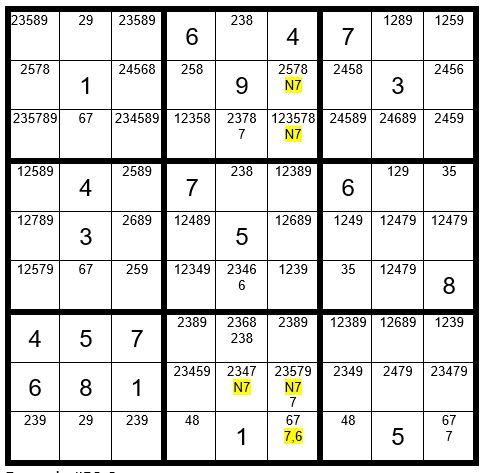
If C6R9=6, then C9R9=7. Note these values are also placed in the second level of the cells per above. Continuing on, C5R6=6. Then C5R7 has options 238, forming an obvious triplet with cells C5R1, C5R4 & C5R7. As such, C5R3 can only be a 7, so we have already learned that C6R2 and C6R3 cannot be a 7, regardless if the driver cell is a 7 or 6, and the 7 can be eliminated as an option from those two cells!
Looking ahead we now see that C6R8 is the only remaining cell in column 6 that can be a 7; therefore, C5R8 also cannot be a 7 for the same reasoning. So, in short order we have learned what we set out to accomplish. But can we learn more?
We will continue to track the 6 in C6R9 as per Example #58.7 below:
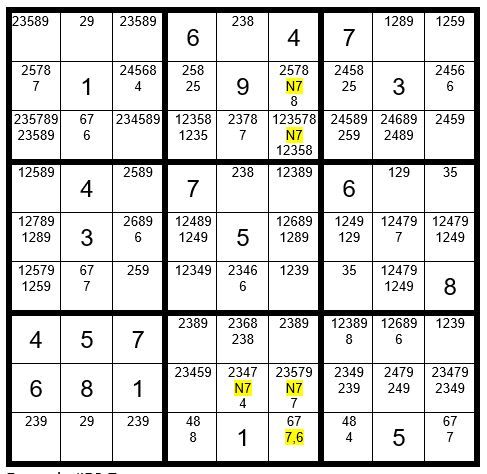
It is clear that now C5R8=4, C2R6=7, C2R3=6, C9R2=6, C8R7=6, C3R5=6, C1R2=7.
Notice that we are starting to work only on the 2nd and 3rd levels of the unsolved cells, to preserve the orig-inal puzzle in level 1. C8R5=7, C4R9=8, C7R7=8, C7R9=4. You now have an obvious pair in C4R2 and C7R2, and hence C6R2=8, and C3R2=4. As you continue tracking the 6 in the driver cell, you find that you have the following, Example #58.8 below:
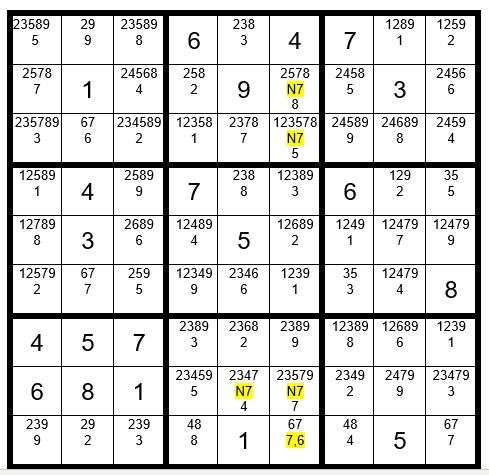
Essentially, we solved the puzzle, as the 6 tracks through the puzzle to completion.
There are many ways a Step 7 can play out. This is obviously a very successful way.
May the gentle winds of Sudoku be at your back.
Dan LeKander, Wellesley Island
Editor's Note: In January 2016, we published a final article in Dan's series of steps to learn the logic of Sudoku – but many of us enjoy using “Dan’s Steps,” so when he asked if we would like a puzzle to solve every month … this editor said an enthusiastic… Yes, please! Now we are several years later and on Puzzle #58
I suggest you purchase Dan’s book: “3 Advanced Sudoku Techniques, That Will Change Your Game Forever!” Purchase of a book includes a 50-page blank grid pad, 33 black and two green tokens, to assist with Step 6.…
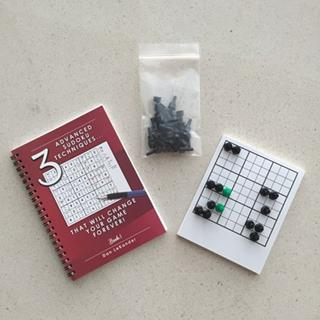
The book is available online, amazon.com and on ebay.com.
Most importantly, I ask that you leave comments on any part of his series and throughout the year.
And now we are in September 2019... many puzzles later... I want to thank Dan…and his proofreader… Peggy! I am hoping you will enjoy our monthly Sudoku and at the same time join me in saluting Dan - Bravo to you both…(Mind you sometimes I am certainly not so polite when I can't solve the puzzle...)
Be sure to read the review of Dan's book by Jesse Kahn published in Jun 2015.
Also all past Sudoku Puzzle Challenge beginning: February 2016, March 2016, April 2016, May 2016, June 2016, July 2016, August 2016, September 2016, October 2016, November 2016, December 2016, January 2017, February 2017, March 2017 , April 2017, May 2017, June 2017, July 2017, August 2017, September 2017, October 2017, November 2017 , December 2017, January 2018, February 2018, March 2018, April 2018.May 2018, June 2018, July 2018, August 2018, September 2018 , October 2018, November 2018, December 2018, January 2019, February 2019, March 2019, April 2019, May 2019 June 2019,July 2019 and August, 2019.
Posted in: Volume 14, Issue 9, September 2019, Sports
Please click here if you are unable to post your comment.
